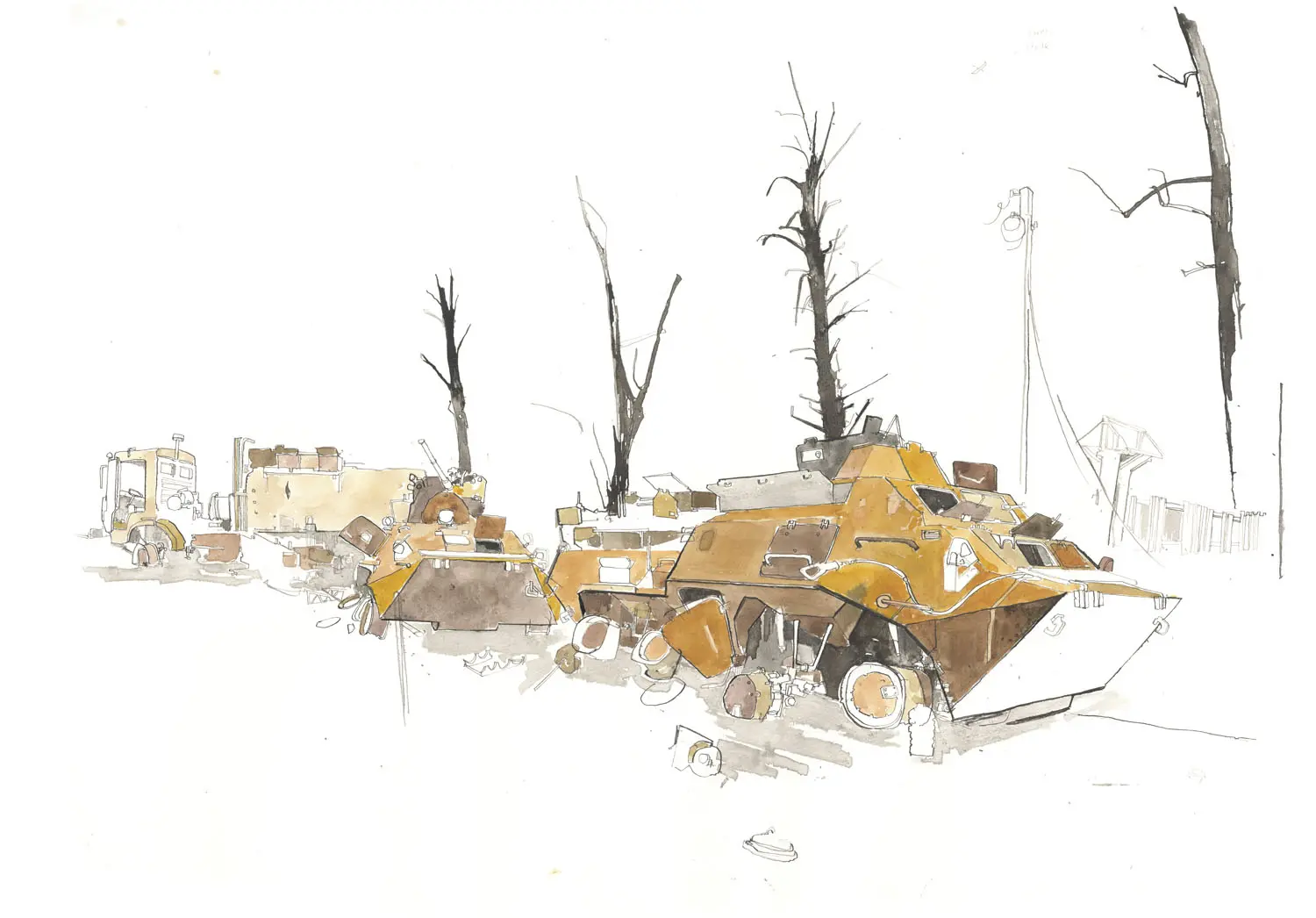
This story was produced in partnership with the Pulitzer Center.
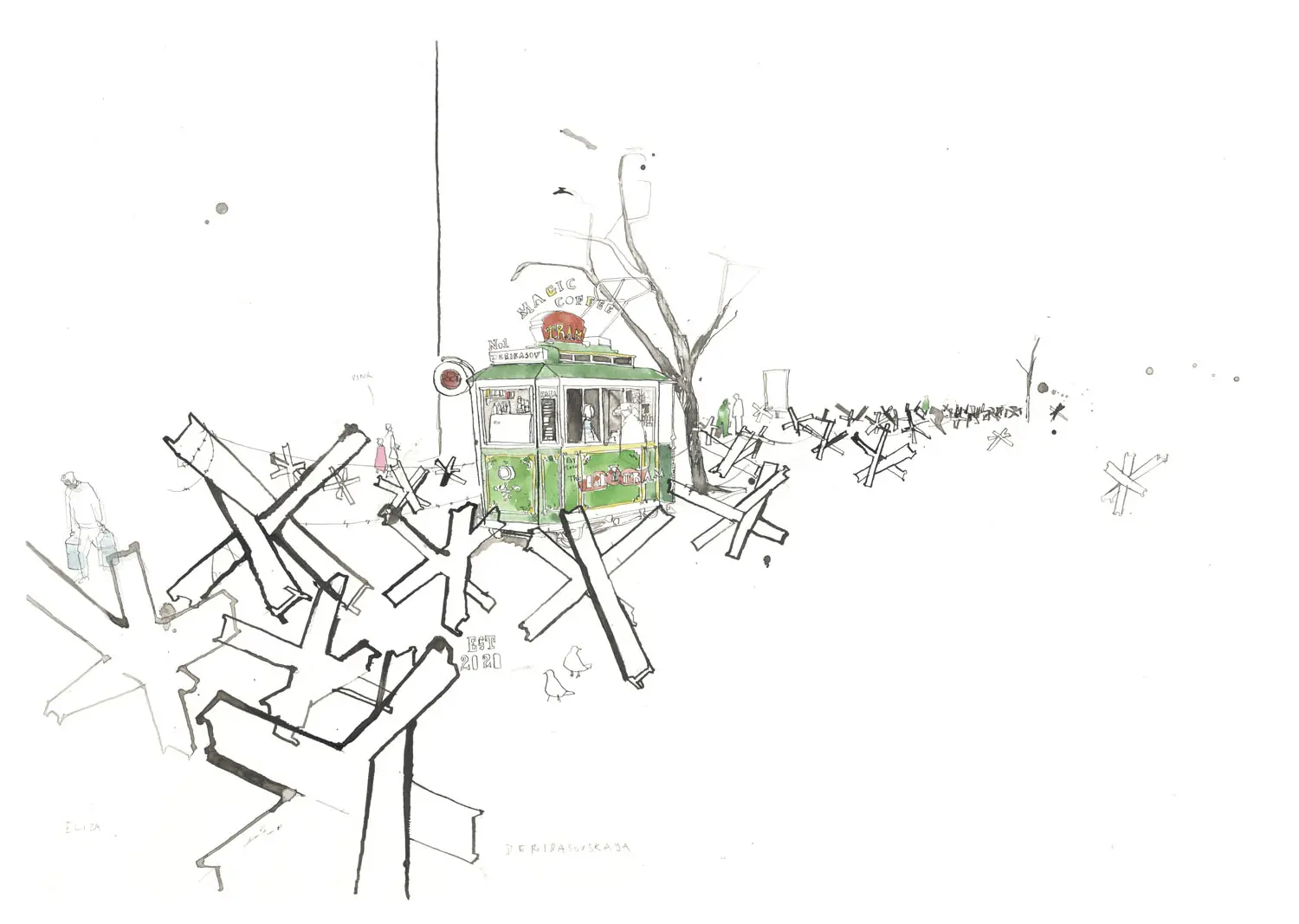
Odesa
March 10
The bustle of daily life is notable only by its absence. This isn’t yet a city at war, but is certainly preparing for it, for what is happening across the rest of the country. In many ways, the preparation—the excruciating ritual of waiting while following the news of what approaches—is as traumatic as the fighting itself.
This war has impacted every inch of the country and of Odesa, the nineteenth-century jewel of the Russian Empire. Tank traps and sandbags clog the main roads. Barbed wire blocks off cobbled streets and cuts through the views and vistas. Access to the streets near the port has been banned for the press, and my approach here as an artist has so far offered no exception. No loitering. Phone numbers of press officers have been distributed, but our calls to them have gone unanswered.
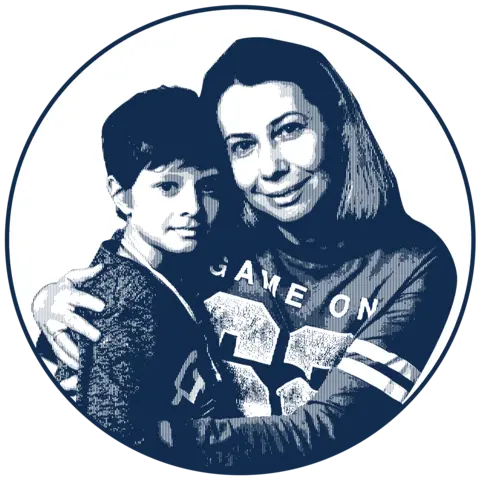
As a nonprofit journalism organization, we depend on your support to fund coverage of global conflicts. Help us continue funding the hard costs of in-depth coverage of the Ukraine invasion—including travel, hostile environment safety training, and the increased security expenses that arise from reporting in war zones.
Instead, I find pockets of life in the market, which, away from the heavily fortified port, has all the hustle and bustle of a downtown mall—a butchery section, a fish counter, and informal stalls selling home-grown vegetables. Other merchants sell underwear, flowers, and an endless supply of SIM cards. In these moments, the war can almost be forgotten, but not for long. Soon enough, the national outcry is led by air-raid sirens that rattle your ear drums, wailing regularly across the town, the oblast, the country.
It’s always difficult to gauge the severity of conflict from far away, through headlines. War is full of hypocrisy. Life and death run side by side in competition. Emotions are stratospherically high. And yet boredom reigns and nights are long. Drawing has become the only way I have found to comprehend it—slowly, sitting on the floor and listening to those who know the circumstances intimately.
On Derybasivska Street, Eliza, seventeen, runs a small coffee shop in an old city tram surrounded by blockades and concrete blocks. Customers weave their way through metal structures and around barbed wire. Dog walkers do the same. On each corner, a pile of sandbags is manned by two or three young soldiers, polite but firm with journalists like me when we ask to visit the area around the port.
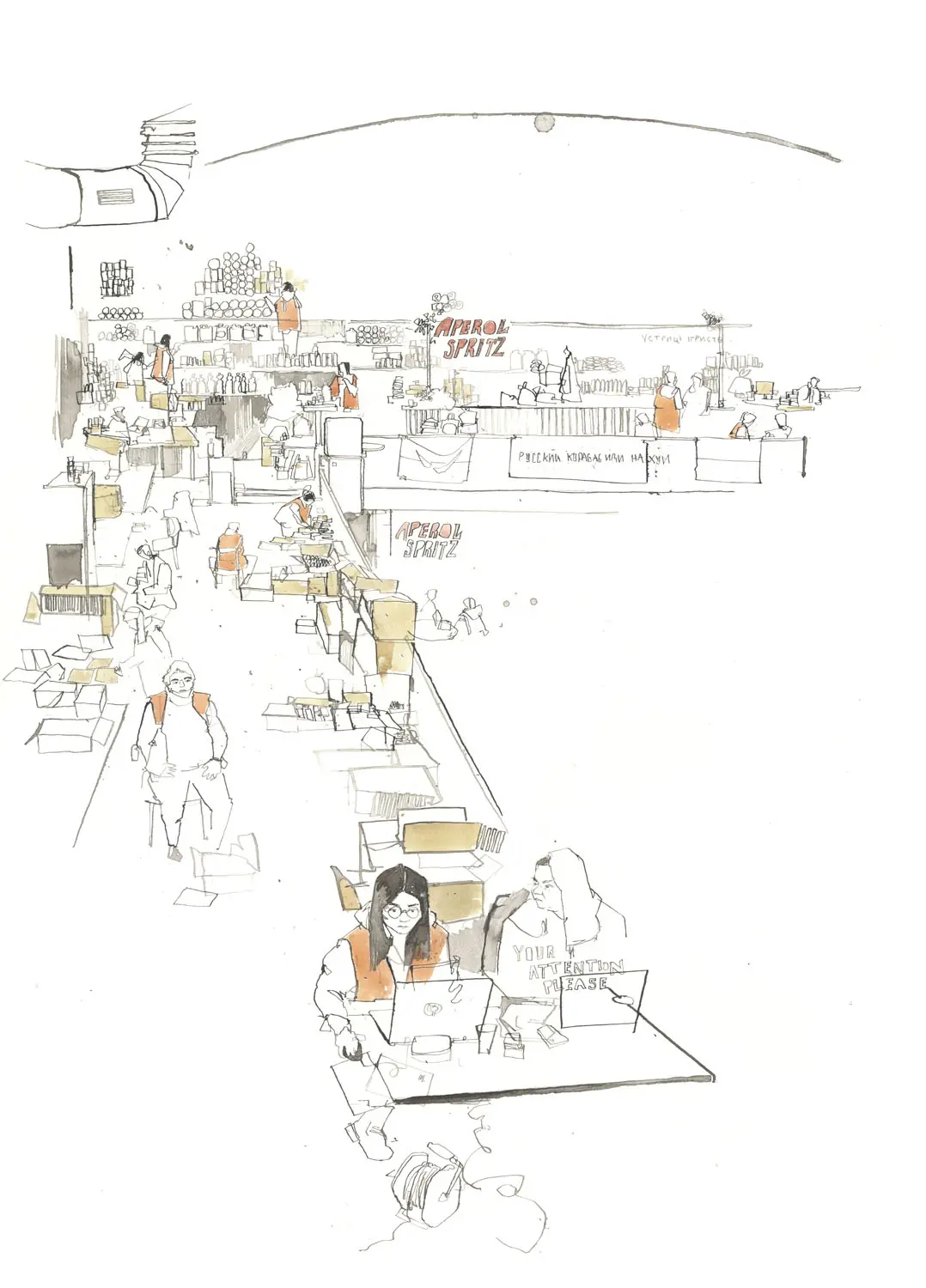
Nearly four million people have left Ukraine by now. Those who’ve remained have found roles in the war effort, turning their skills in industry or commerce to a task that might contribute to victory.
In the Odesa Food Market, usually a trendy hall full of food shops, hundreds of volunteers now work to collect toiletries, consumables, pet food, and clothes, which they pack into boxes and distribute across the country. Thousands of meals are made in the restaurants’ kitchens, delivered to the territorial defense forces each day. The conviction and the valiance by which Ukrainians go about their work is staggeringly assured.
Outside this volunteer station, the street leading to the famous National Academic Opera and Ballet Theatre is blotted with the dark shapes of tank hedgehogs. Stenciled across one of them are the words русский корабль, иди нахуй, which is Russian for 'Russian warship go f--- yourself,' a slogan born from the Snake Island incident that has been posted and scrawled all across the country as a rallying cry (and will eventually be issued on a postage stamp around the time that the Ukrainian military sinks the Russian flagship Moskva in the Black Sea).

The curfew runs from 8 p.m. to 6 a.m., which means that anyone catching a train across the country needs to arrive at the station several hours before the overnight trains depart. The trains heading west—to relative safety—are free for Ukrainians.
In the enormous lobby of the Odesa station, families squeeze into chairs with their belongings kept close. Soldiers come around to kick out anyone without tickets, which seems a little unfair, but rules are rules. A man next to me pulls out a guitar, and under the light of another passenger’s mobile phone, he begins to play a few Ukrainian songs. His friend goes round the room handing out tulips to women. The stationmaster comes to tell him to quiet down, but the travelers encourage him to keep playing. Vlad is going to visit his family across the country. My drawing of him isn’t very good, but it’s the feeling of the moment that seems more important than any technical execution. This happens a lot in Ukraine: When listening to stories of grief or great vulnerability, the drawing, good or bad, becomes secondary to the testimony of the person sitting in front of me. The image becomes the reason to listen, rather than the focus.
Kyiv
March 21
Access to military hospitals has been difficult since the Ukrainian government wants to restrict information on troop losses. But in Kyiv City Clinical Hospital No. 1 I’m shown around by the director, Oleksandr Ivanko. He introduces me to Lydia, who shows me the shrapnel that has just been removed from her mother’s arm after a shelling a few days before. Lydia herself wasn’t uninjured, but here in the hospital she describes how her grandmother, Nina, wasn’t just killed by the blast but “torn apart” by it. Lydia, alone and with nowhere else to go, buried Nina in her garden.
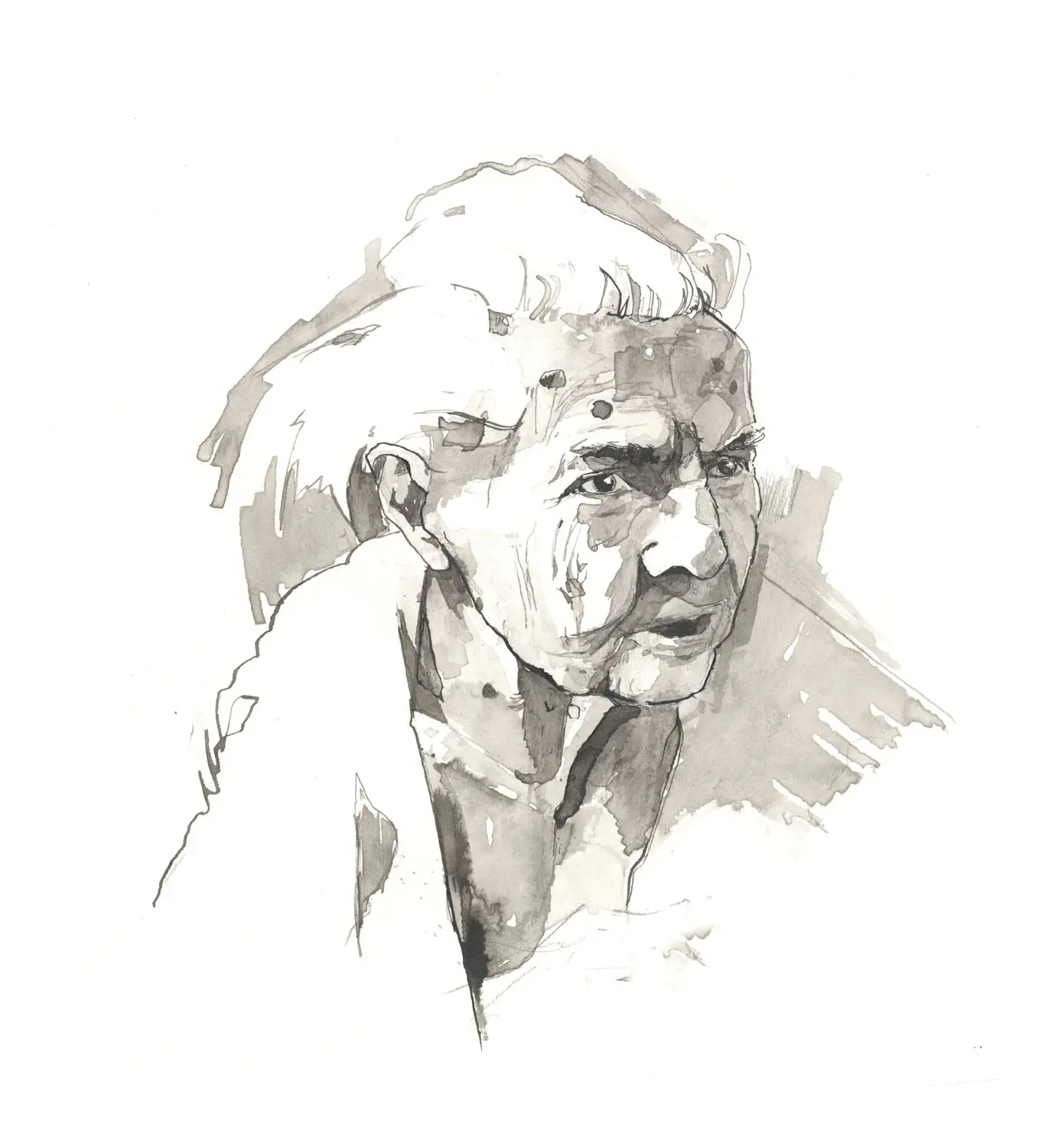
In an apartment block in Kyiv I meet Madame Olga, born in 1922 in the Soviet Union. She survived Stalin’s Terror-Famine before being captured by the Nazis, and was sent to Dresden as a forced laborer to work for a German couple for three years. (Their cruelty resurfaces in the telling, including her being fed “worms as fat as your fingers.”) She lived through the infamous British shelling of Dresden in February 1945, which reduced the city to rubble. At the end of the war, she began the long walk home to Ukraine, meeting a Soviet soldier along the way. They later married.
Her great-great-granddaughter is seven, and has fled to Germany because of the war. They hope to meet again for Olga’s one-hundredth birthday in August. “It’s funny that war can tear me up like this,” she says. “I want to simply forget everything.” In her fear and confusion, she thinks Hitler is attacking Kyiv. “God forbid this,” she says. “Huge trouble has come to us. Ukraine must stand.”
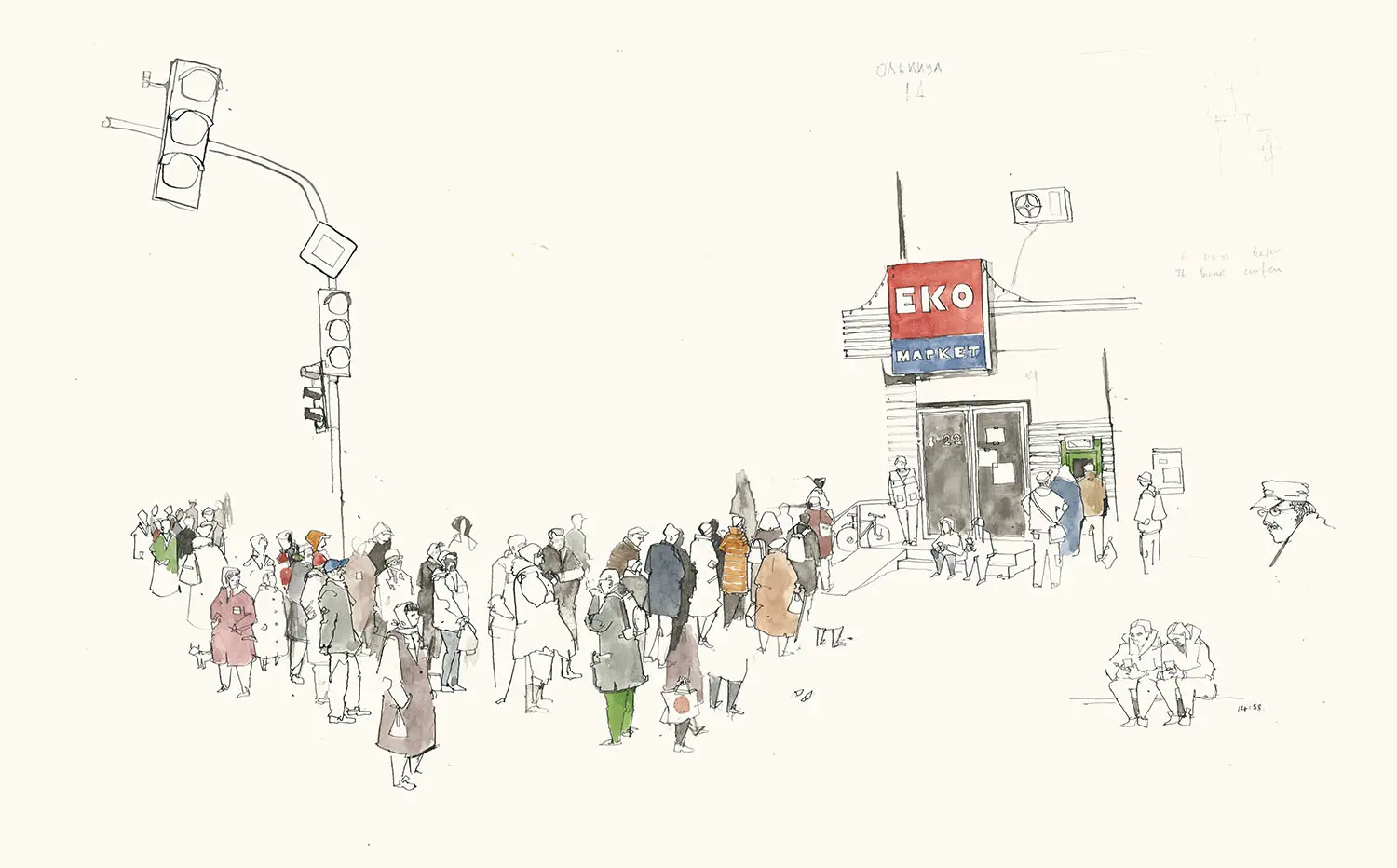
The trains in Ukraine seem to be running, vital lifelines for those escaping the Russian bombardment. On the train to Kharkiv I meet a young man returning to help his father-in-law pack up his biscuit factory, collect the car, and head west to safety. The man sharing my cabin tells me he fled with his family into Russia, then traveled through the country to the Baltic states, then Poland, then down to Italy, where he left his wife and children before returning to help with the war effort. We pull into Kharkiv station at 4 a.m. and, along with other travelers, settle in to sleep briefly on the station floor (our spot was behind a coffee machine) before being allowed out again at 6 a.m.
I take a taxi to a small hotel, and I thank the taxi in Russian. “No, No!” he says, “Dyakuyu is Ukrainian, Spasibo is Russian. Russia—bad!” The majority of the population in Kharkiv speak Russian. Some are trying to do anything they can to reject its influence.
Kharkiv
Serpnia 23 metro station
March 31
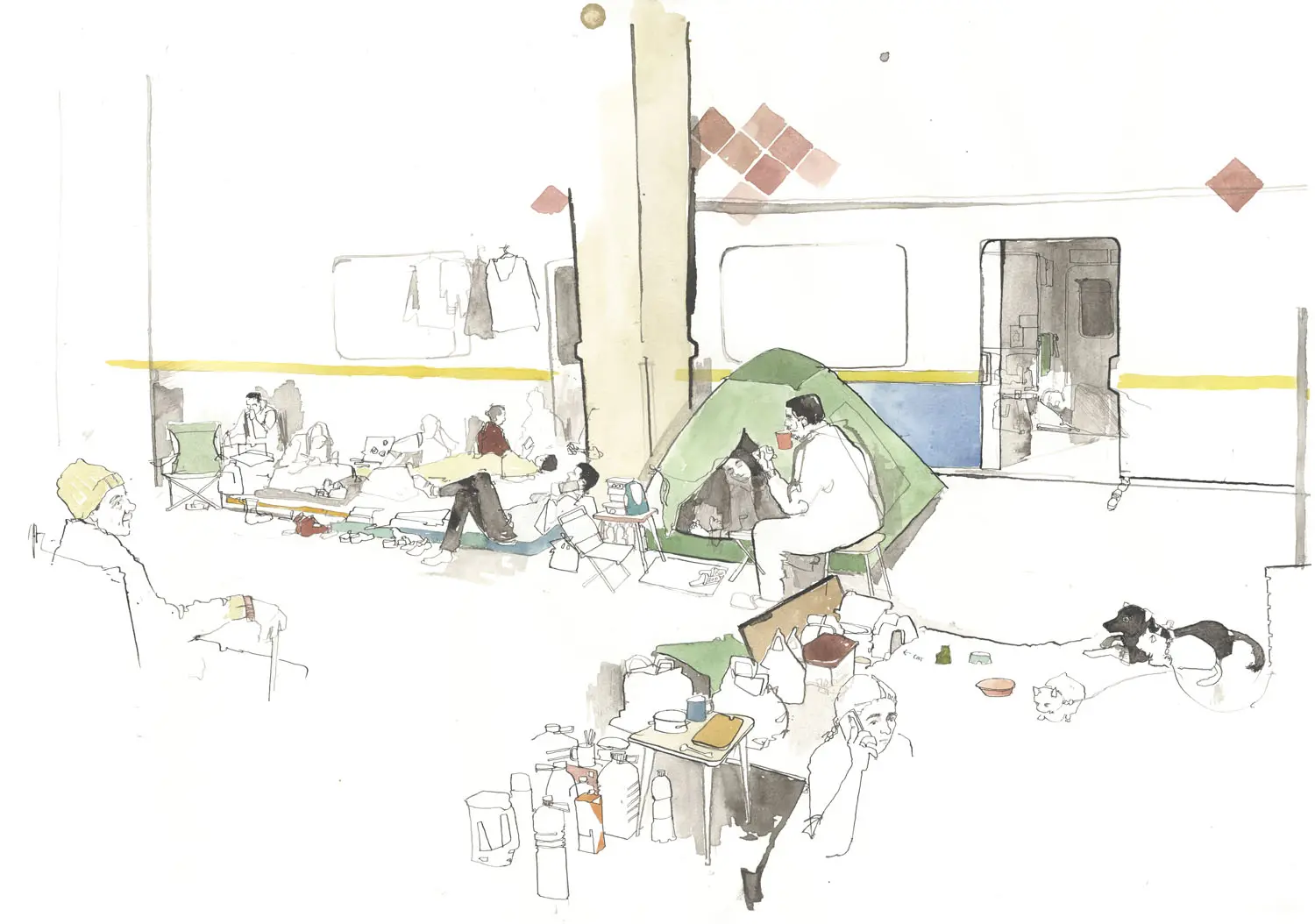
In the metro is a scene we thought we’d written into the history books. In 1940 Henry Moore drew people sheltering in the Belsize Park London Underground station, hoping to survive the German air raids. These drawings became iconic for the British public, and served as societal footnotes for what to avoid in the future. Today, on the other side of Europe, thousands of civilians sleep in Ukraine’s metro stations to avoid the Russian bombardment.
This station in Kharkiv is no different. The metro sits deep underground, down stone stairs and through heavy fire doors, Soviet in style and guarded by several territorial defense soldiers. The temperature drops dramatically as you descend. There’s a stale smell. The bright lights remove any sense of time passing.
During the day, the station is relatively empty, its residents heading up to the outside world to check if it’s still there, to see if their homes are still standing. In the evening, the platform fills up with about four hundred breathing beings—women, children, the elderly, and numerous pets in a busy warren that has become their dormitory.
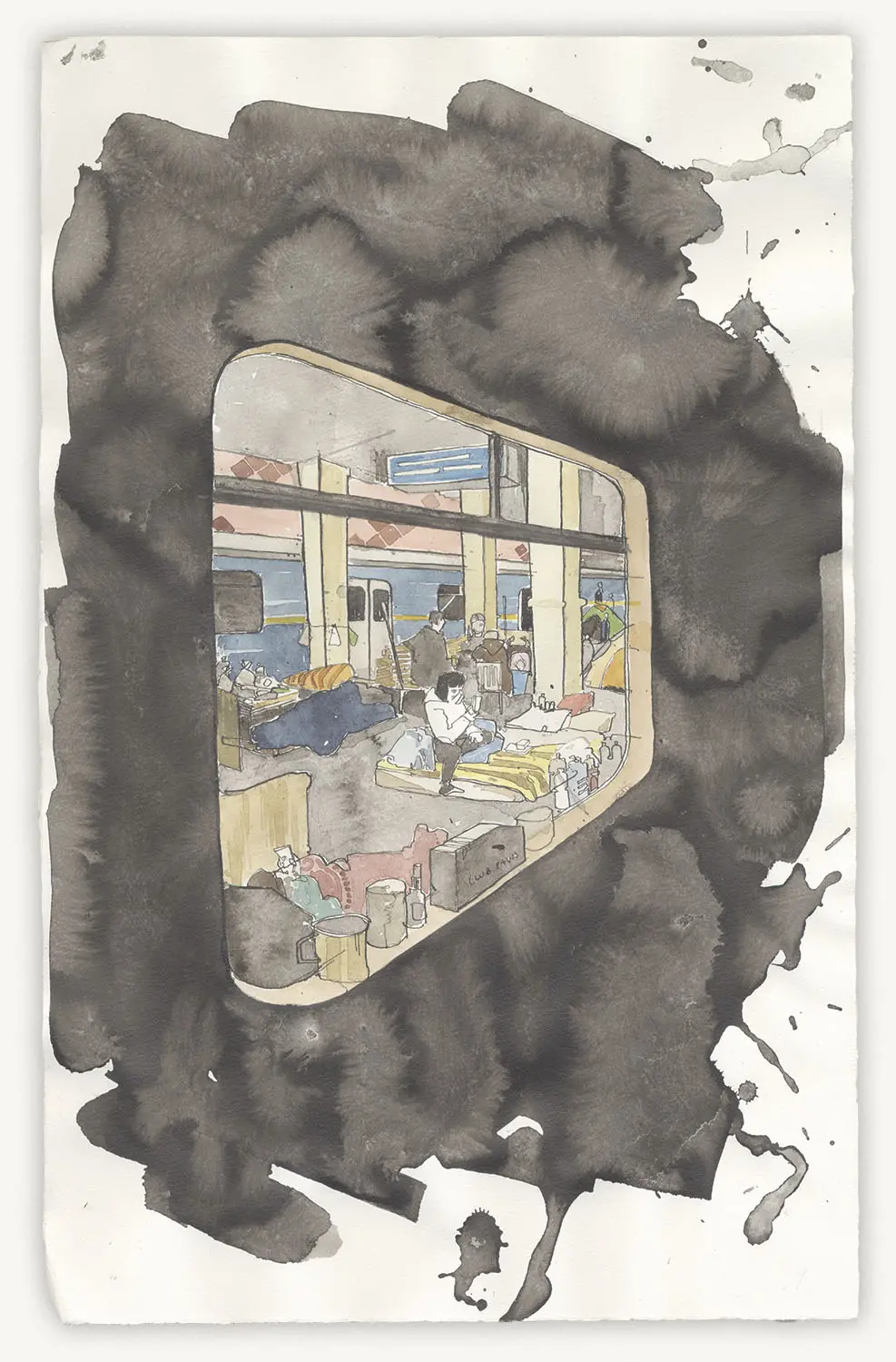
All along the platform and up the steps, the floors are covered in a patchwork of bright colors from Ukrainian homes—mattresses, bedding, blankets with people resting underneath, shapes not unlike the shapes in Henry Moore’s drawings, so still they almost go unnoticed. Roll matts, pet boxes, and cushions have been set on wooden pallets to keep bodies off the cold marble. The platform is sandwiched between two blue and yellow trains sitting idle, doors open, figures huddled in the darkness inside. The same bright patchwork runs the length of the carriage floors, with other effects of temporary homes: tea sets on stools, toiletries on the seats, groceries hanging in plastic bags from the grip bar. The platform lighting never really makes its way in here. Faces are often lit only by the light of a mobile phone.
With each trip up to the outside world, another item may be brought back. Someone will bring chairs down, or a small table, or the odd piece of modern furniture that looks out of place against the station’s pink tile and efficient Cyrillic signage.
Around lunchtime, a queue forms down the platform. Each person has Tupperware in hand to receive a portion of soup—borshch today, and probably borshch tomorrow, the pride of all Ukrainian kitchens. The soup is delivered and served by volunteers who’ve abandoned their old professions to focus on this more elemental service, be it baking or cooking or factory work. Still yet more volunteers run a delivery service to those in need, and to their much-loved soldiers at the front.
With many of the men away fighting, the Kharkiv Metro has become a microcosm of what’s left of Ukrainian society. In this dark and wretched bunker, an artist teaches paint-by-numbers to children and anyone else seeking a break from the monotony of living here. A former university teacher hosts primary-school classes and stages puppet shows, just to stave off the boredom; at the other end, a few people run a cinema (tonight, Toy Story 3), with the station steps used as seating for the audience. A masseuse has set up her practice in a control room. Among the dwellers here, I meet an engineer, a real-estate agent, a teacher, a restaurant manager, and a forensic scientist. Whatever their calling was before the war is now on hold while they perform these small but extraordinary acts of defiance against a megalomaniacal Putin.
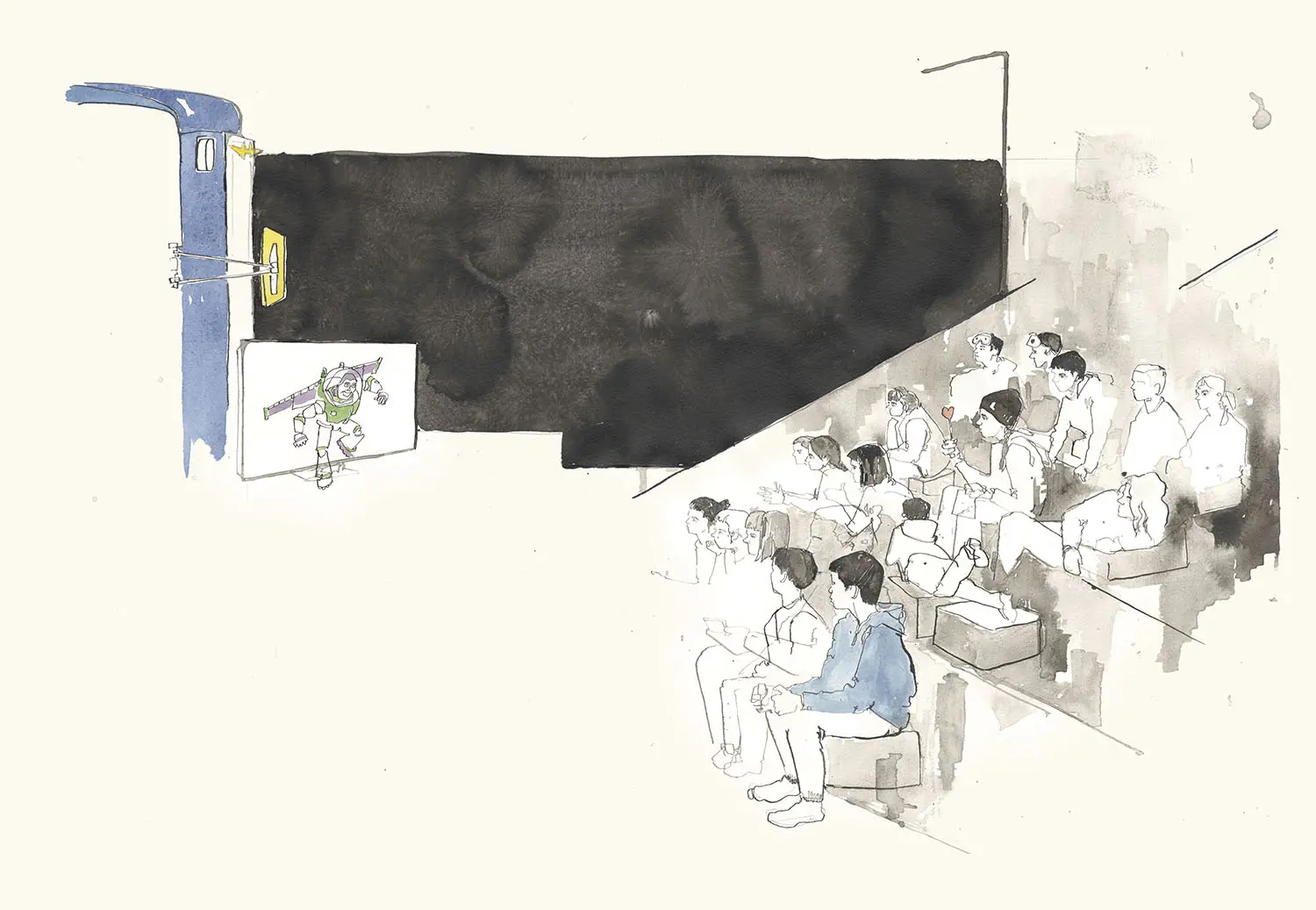
While drawing I begin to notice the mannerisms of metro life, the reserved nature of the families here, whispering and keeping to themselves. There’s also a resilient energy that suggests they’re prepared to do whatever it takes to survive. I’m offered stools to sit on, tea, borshch, and a place to sleep. One man suggests firmly that I don’t draw him. “We are like rabbits in a zoo,” he says. I can only imagine a citizen’s reaction to the overwhelming number of journalists that have passed through Ukraine in the last month. The novelty of the mainstream media has worn thin quickly.
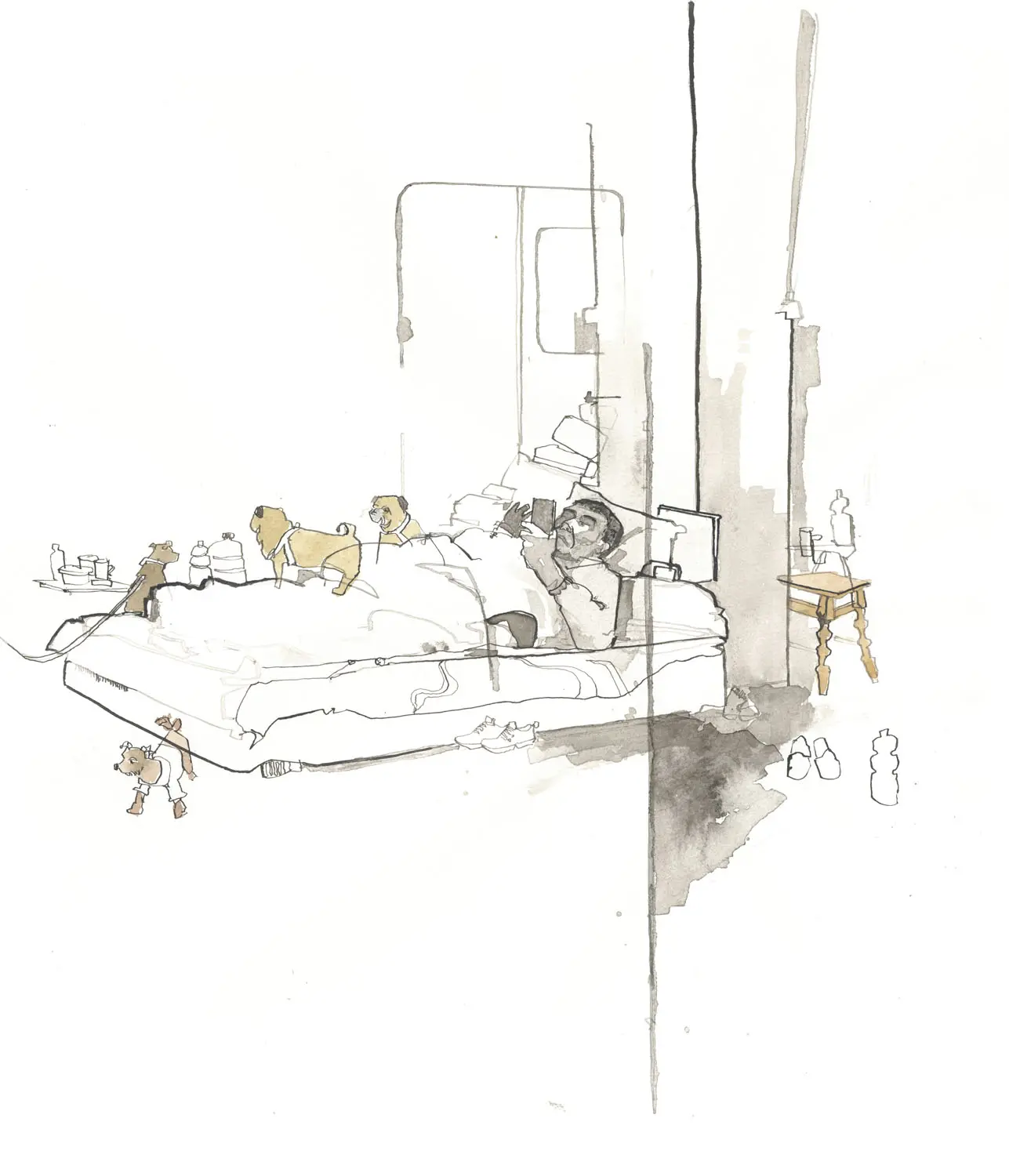
Katerina, twenty-seven, shares a bed on the platform steps with her mother and father. Along with other women (and girls too), she’s been writing letters to the soldiers at the front. No one here expects a reply; the letters are simply meant to encourage soldiers and reassure them that a nation is with them. Our conversation is interrupted by a voice blaring out of the public-address system reminding kids that the day’s lesson is about to begin—not any kind of formal schooling, just a chance to play football or dance in the small space set up near the ticket barriers, or time to color, using the floor as a desk. Routine and organization are vital down here.
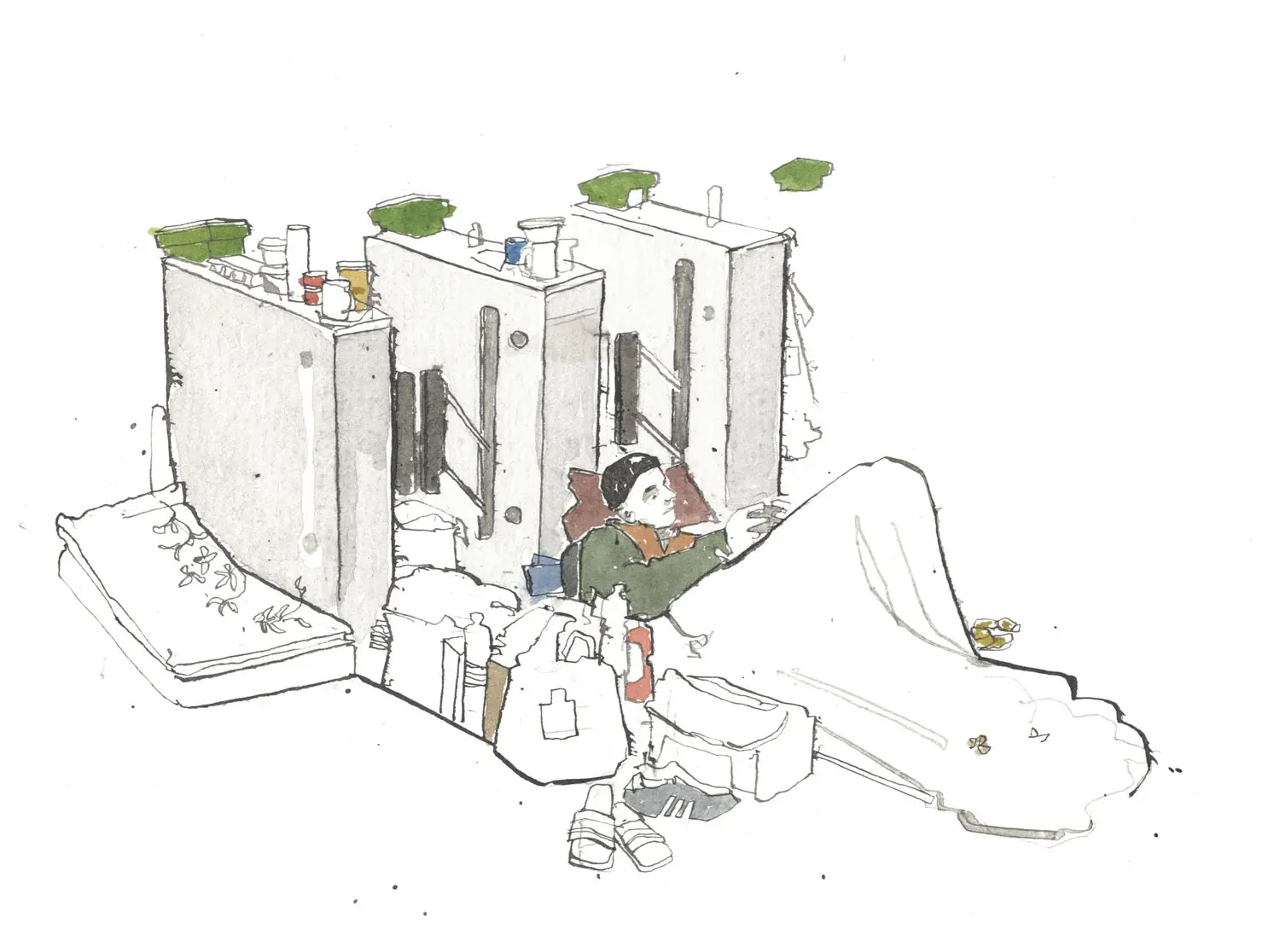
At the end of the platform, past a girl drying her hair, is a small room. Before the war, it was the station rubbish dump, but Sergey, a twenty-one-year-old medical student, has turned it into a makeshift walk-in clinic. A stool, a stethoscope, old fruit boxes full of medicines (one for chest, one for head, and a banana box for children). Sergey laughs at the absurdity of it—medicine in a fruit box—but he takes his mission quite seriously. “I didn’t want to leave” when the Russians invaded, he says. When I ask him why, he answers, “I don’t know, honestly. Why must I leave? I was born here. Except for five years, I’ve lived here all my life. And I have my work. Important work,” he says.
There is, of course, great hope among the people I meet down here, that if the war ends quickly their lives might return to something resembling ordinary. And yet as each day passes this seems more and more unlikely. Within a single month, every aspect of Ukrainian society has been contorted and stretched by this war. Many of the scenes on the front pages of newspapers back home in London show the immediate terrors. What I’m witnessing, it seems, are the knock-on effects of that horror: the empty streets, the disabled trams, a silence and a cold when the heating goes off in the apartments. Those sensations, though minor compared to the relentless thunder of the shelling and the nauseating fear of Russian military success, will also be embedded in memory for generations to come.
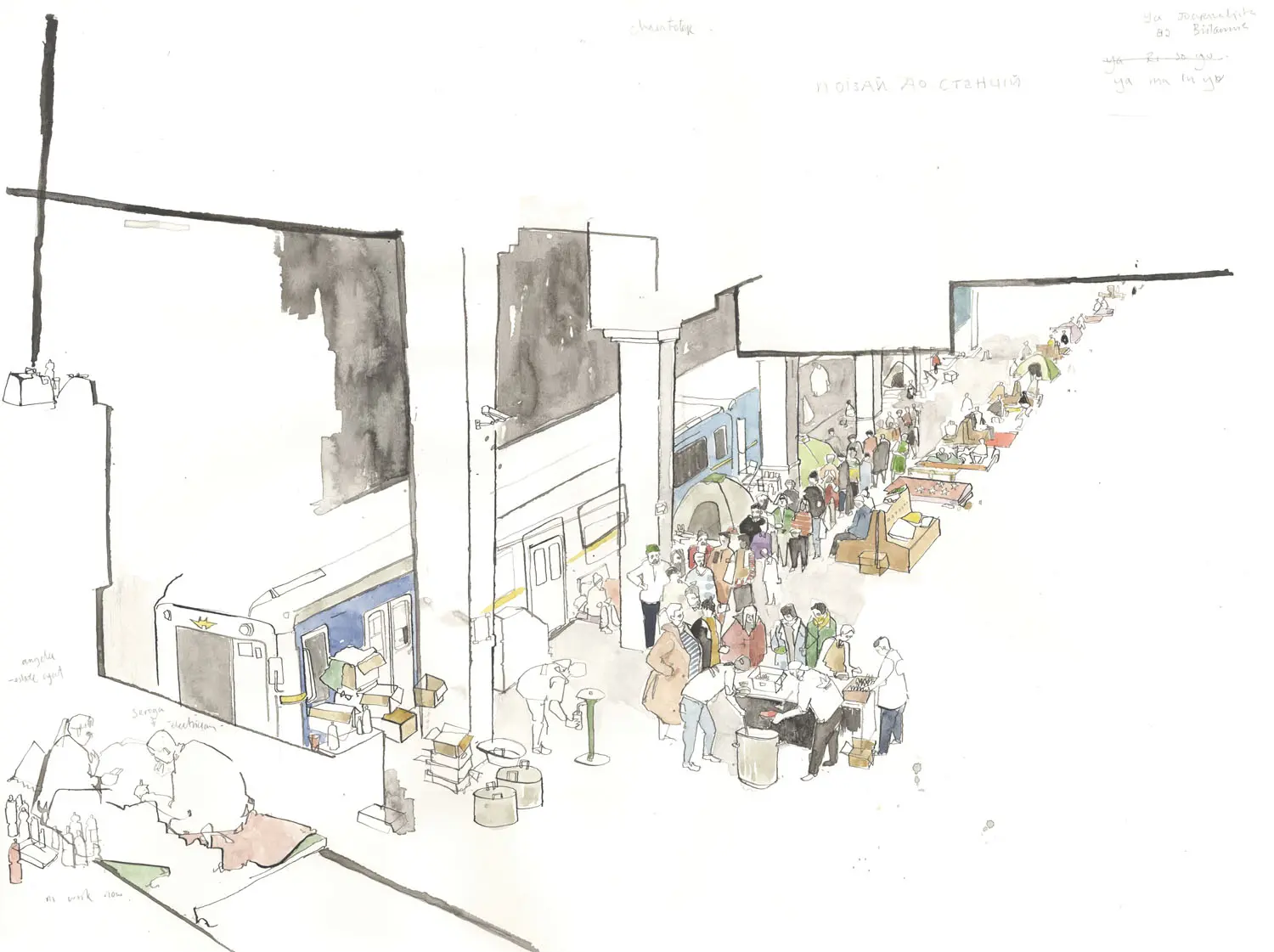
Kharkiv Clinical Hospital, Balakirjeva Street
March 29
Kharkiv, a city of 1.5 million before the war, has been under constant bombardment for several weeks. Government buildings have been shattered by long-range missiles designed for mass causalities, and which are difficult to guide. Hundreds of artillery shells have fallen on Kharkiv for over a month, forcing about half of the city’s population to flee by any means possible—cars, buses, taxis, or by cramming into the 8:30 a.m. train to Lviv, or any station west of here, for that matter.
In a ground-floor operating room, its windows taped up with cellophane, a patient named Denys lies surrounded by some of the country’s greatest medical minds, who at this moment are drilling into his head. After a few minutes of drilling, the lead neurosurgeon, Kyrylo Dukhovsky, removes a piece of skull—just six centimeters wide—from just above the patient’s right ear in order to access and extract the hematoma in his brain. Oleksandr, Kyrylo’s father, watches nearby—two generations of doctors who, like carpenters and farmers the world over, are keeping this line of work in the family.
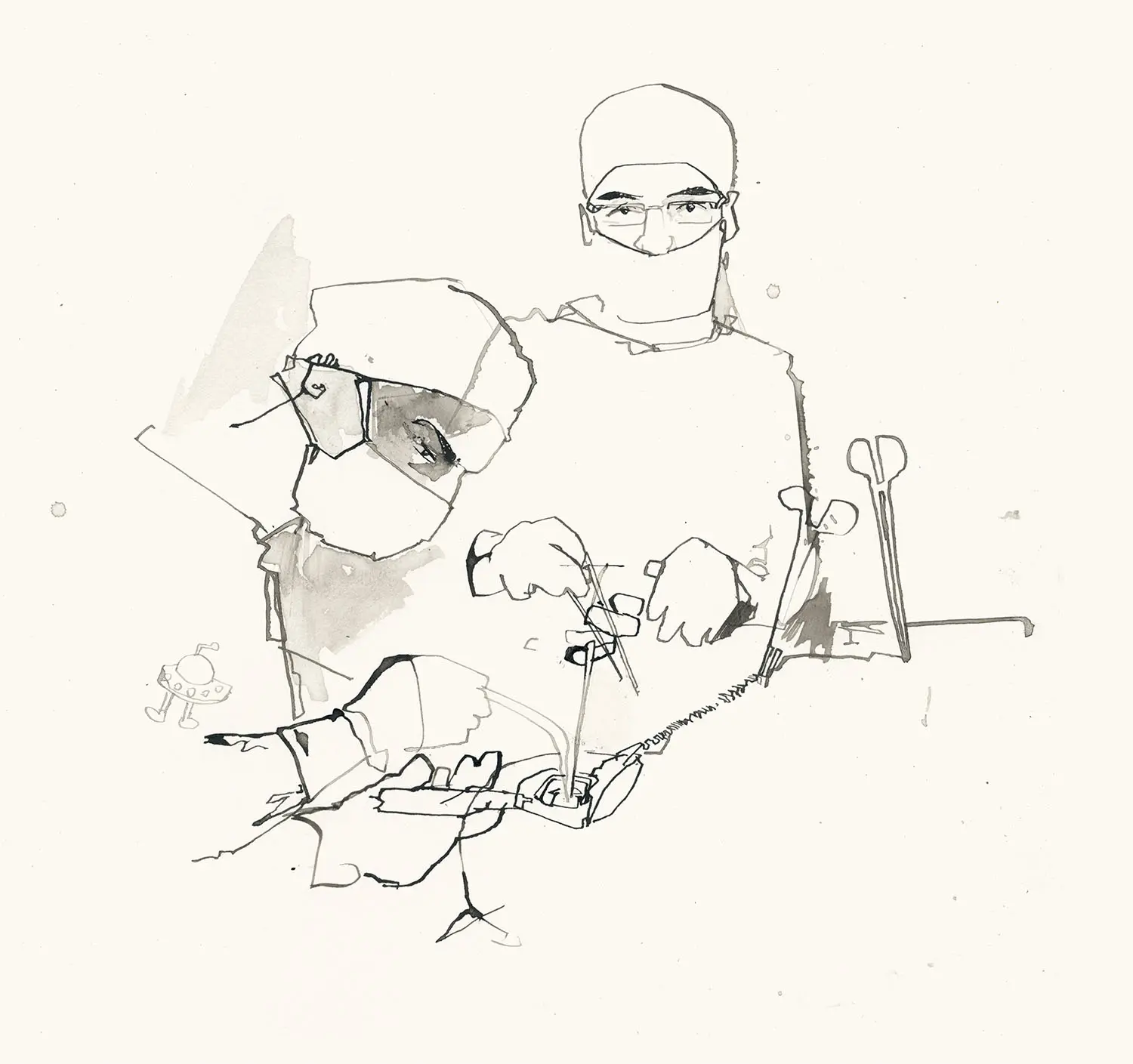
For the time being, they have electricity, clean medical equipment, and are sufficiently staffed. The regular pinging of the heart monitor and the sound of a respirator are subliminally reassuring for everyone. The operation is a success. There is, in fact, nothing unusual about this highly sophisticated scene but for the context in which this team now works. The city is under constant attack, hospitals have been hit across the country. Patients sleep in the corridors—not because the hospitals are overrun but because they fear the windows in the ward rooms will be blown out by missiles at any moment.
On the fourth floor, I meet Volodymyr, seven, bedridden long enough—three weeks and counting—for the muscle wastage to make his body disproportionally small for the size of his head, which has been wrapped in an enormous bandage affixed with multicolored animal plasters. His father, Stanislav, tells me the story of how they ended up here. On the last day of February, Stanislav’s wife, Daria, fearing for her sons’ lives, loaded them into the car and left their apartment for a safer part of town. It isn’t clear what triggered the incident, but he tells me their car was fired upon by Ukrainian soldiers. Daria was killed, while a single bullet lodged itself in Volodomyr’s skull; Victor, three, remained unharmed in the back seat.
Volodomyr has undergone two operations in an attempt to remove the debris—yesterday’s X-rays revealed small pieces of glass still lodged in his face—and since the incident has had to relearn how to use his legs. Since his son’s injury, Stanislav has been trying to rebuild some semblance of normalcy back into their lives, but it’s an impossibility that settles in with each day that passes. He shows me pictures on his phone. One is of his family at the beach, an annual trip to the Sea of Azov. “It was a tradition,” he tells me. “Our first picture was just me and my wife, then just us and the car, then our first child, then the second child.” The deep rumblings of artillery shells shudder in the distance, in Saltivka. Stanislav scrolls to a picture of their car after the incident, its windshield gouged out by bullets. He doesn’t know when he will ever get answers as to why their own soldiers opened fire, and he’s gotten only slightly better answers on his son’s chances of improvement. Stanislav’s adoration is palpable the more he talks about his boy—about how, before the war, Volodomyr excelled at inventions. “I think he’s a true engineer,” he says. “To me, he’s a genius in mechanics. Since he was three he was building Legos, at home we have shelves full of them.” Despite the weight of this tremendous sadness, Stanislav is grateful. He knows of two other children who died here during surgery—a girl from mortal injuries and a boy whose heart just stopped. “We’re really very lucky,” he says.
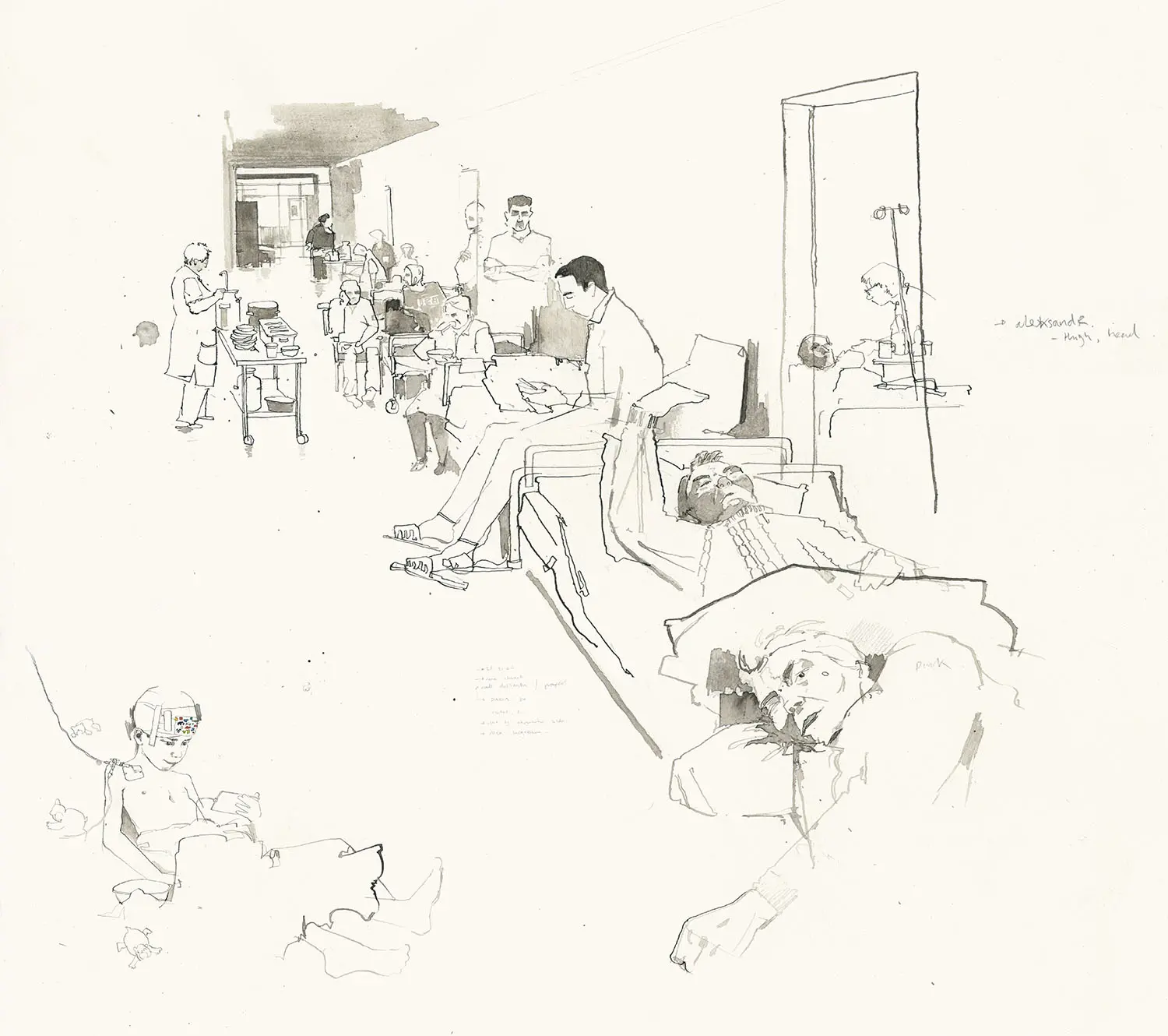
Down the fourth-floor hallway, past the corridor dwellers, I’m introduced to Tatiana, seventeen, accompanied by her mother in a pink tracksuit. Tatiana smiles out of politeness and opens one eye. The other was lost during shelling in Kharkiv. A scar runs from forehead to cheekbone through the middle of the eye socket. Oleksandr describes the cranioplasty they performed. Then I’m left alone in silence. I’ve drawn leprosy amputations in Nepal and in children’s wards in Syria, but there’s something about the realization that I won’t be able to match the symmetry of one side of Tatiana’s innocent face with the other that I shall never forget. It’s as if the ink drawing might permanently record the injury. An injury that should have no place on a face so young.
Those who have stayed are often too compromised to move: the elderly, the poor, the disabled and their caregivers—all unable to make the journey west to relative safety. They know what’s at risk with the threat of advancing Russian troops, a fear that becomes palpable as news begins to filter out that more than three hundred bodies of civilians, some bound and shot execution-style, have been found in mass graves as Ukrainian forces have retaken the town of Bucha.
Bucha
April 6
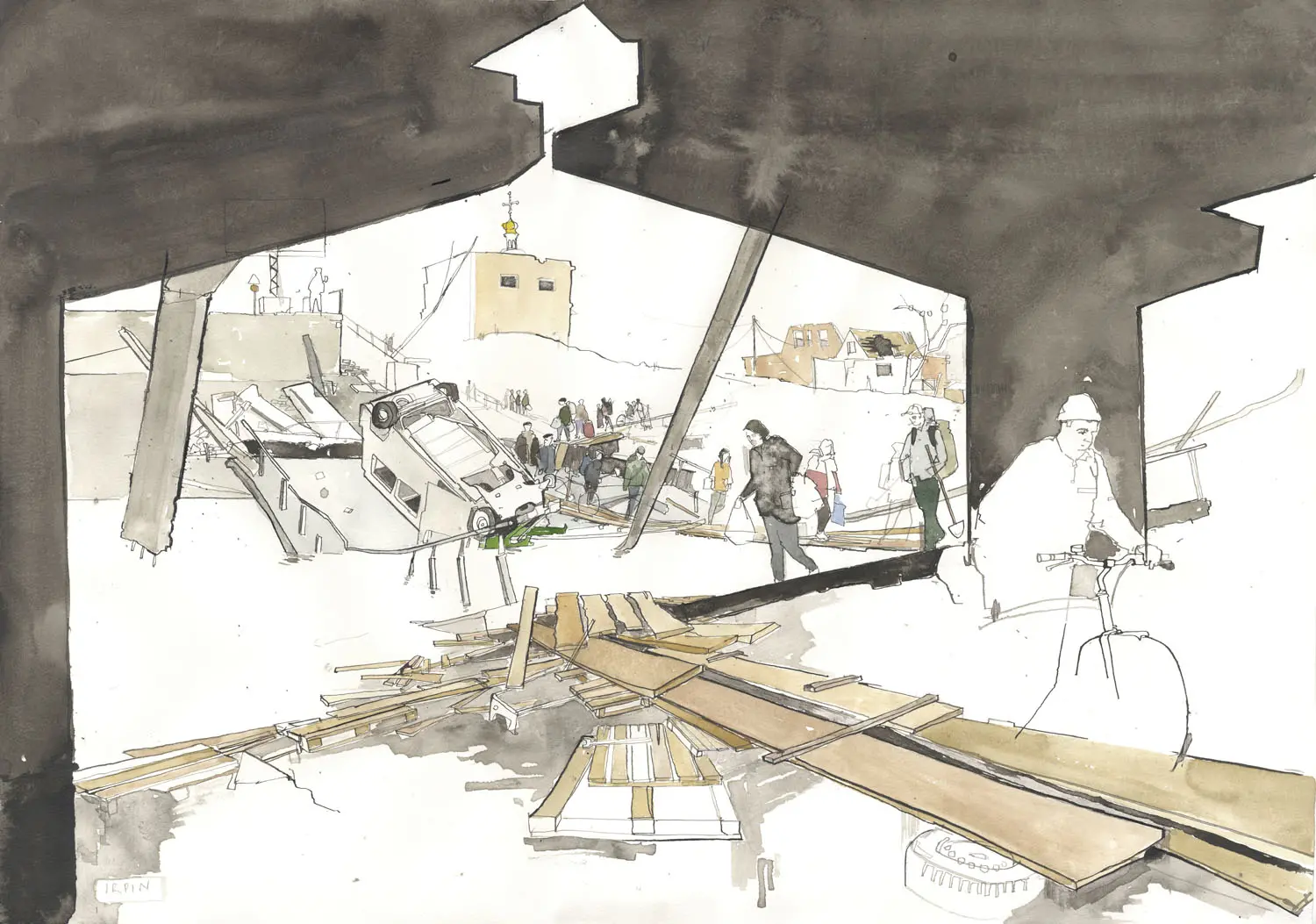
Shallow graves have been dug out in odd places—next to the apartment blocks, beside parking lots. The dead have been temporarily buried by neighbors waiting for families to return, with modest piles of cold earth tossed onto the bodies and small wooden crosses sticking out. A foot pokes out of the dirt. Fifty meters away, people gather outside their homes, partly to stay warm, as the electricity has been off for weeks; and partly, it seems, because being locked underground for three weeks makes any contact with other human beings a matter of survival. To be able to look into another’s eyes and see the affirmation that what they experienced was indeed horrific.
Back on Yablunska Street, a military team prepares to destroy a mortar round lodged, unexploded, in the tarmac of the road. Around the corner is the Russian tank convoy ambushed back in February as it crawled toward Kyiv. I don’t know if I will ever see such total destruction again (and certainly hope I don’t). The smell of burnt paint and melted metal fills the air. Trees caught in the crossfire stand bare and limbless, echoing Paul Nash’s famous World War I painting We are Making a New World, something that seems to be happening in brutal fashion all over again. All of this feels helpless and hopeless, a pathetic waste of time.
For several days since the military opened the street, photographers and news teams from around the world paw over this scene. It is the first “battlefield” access the mainstream media had been granted; images of this place will soon saturate the news. My role in the media seems easy to doubt: Why would anyone want to see a drawing of this? But there is something about the news I see on my phone and the stories I witness on the street that doesn’t quite connect. The news coverage feels distant and stationary and flat. If nothing else, drawing offers a human element. A composite image, by permission of the subjects, that isn’t designed to shock. Drawing, by contrast to the headlines, is through a slower human lens. It offers, I hope, a place on the page to comprehend what has happened here, or is happening, invisible but felt. Glimpses of the human condition that show up in the lines but also somewhere between them.
Church of St. Andrew
April 8
Bodies found in a mass grave are being exhumed. A crowd has gathered, including forensic scientists, the bodyguards of someone important, some territorial defense soldiers, and a priest. Press teams weave among the crowd.
You can feel the mood of the crowd on the other side of the grave. Behind a single strand of white-and-red tape, people stand and wait to see if they recognize a loved one, a painful obligation that brings both devastation and some relief. Many of the missing left their bunkers during the Russian occupation in search of food but never returned. Families have been worrying for weeks. Some of the missing have been identified here.
Four men in white forensic suits stand waist-deep in this muddy grave—inverted silhouettes against the dirt walls. An arm sticks out of the ground, a shoe sits unclaimed on the surface.
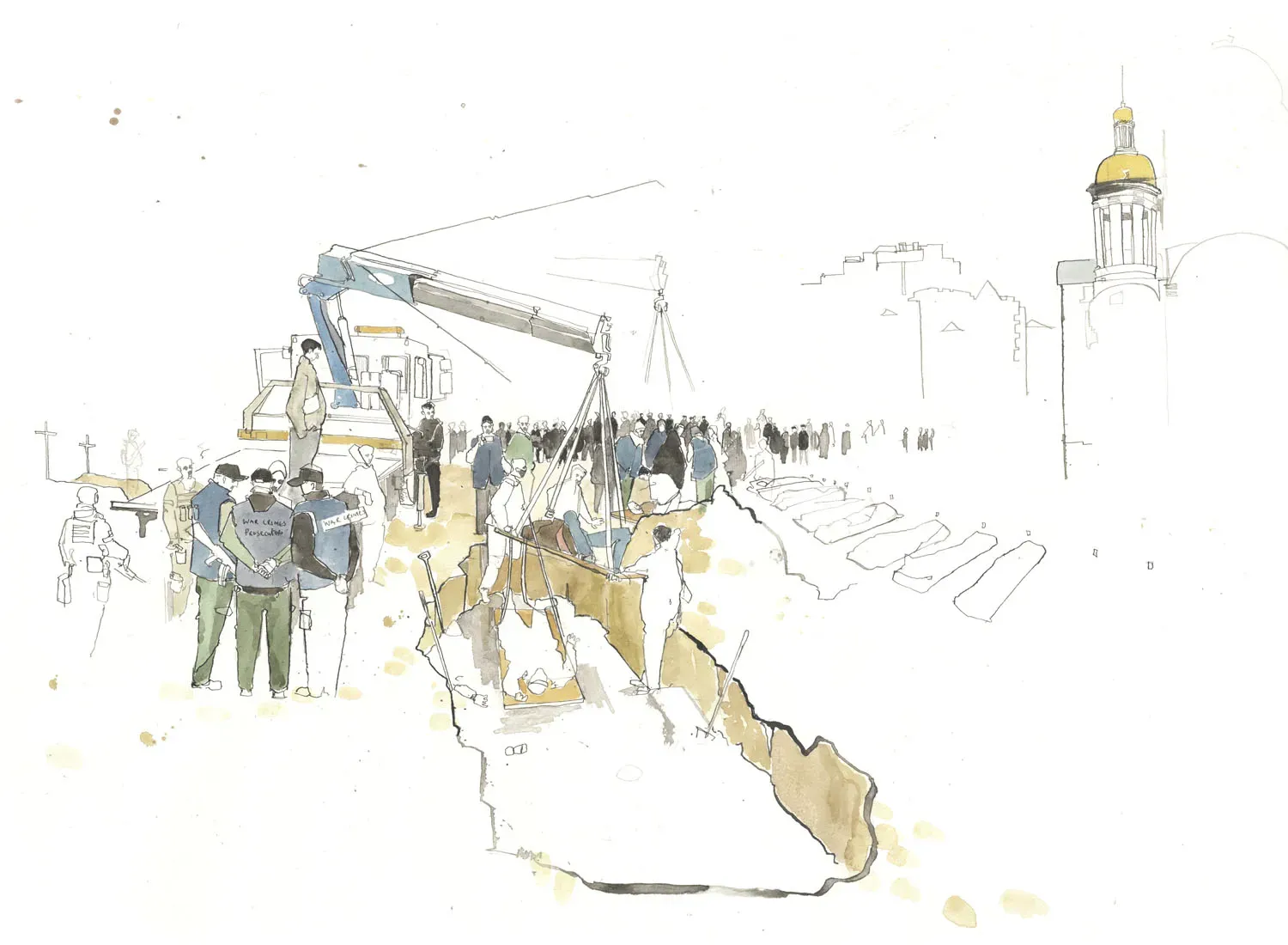
Everyone avoids making eye contact. The man operating the loading arm, usually reserved for lifting stone at building sites, turns his head away as the next body, blindfolded with gray stubble, is lifted onto an old, wooden door being used as a stretcher.
The bodies are numbered, placed in black body bags, and set on the ground in front of the church. Photographers close in, cameras click and whir as the dead are laid out. Residents and family, barely able to keep their composure, obligingly answer reporters’ questions. And then, over at the church car park, a busload of reporters, dozens of them, arrives on a government-managed press tour.
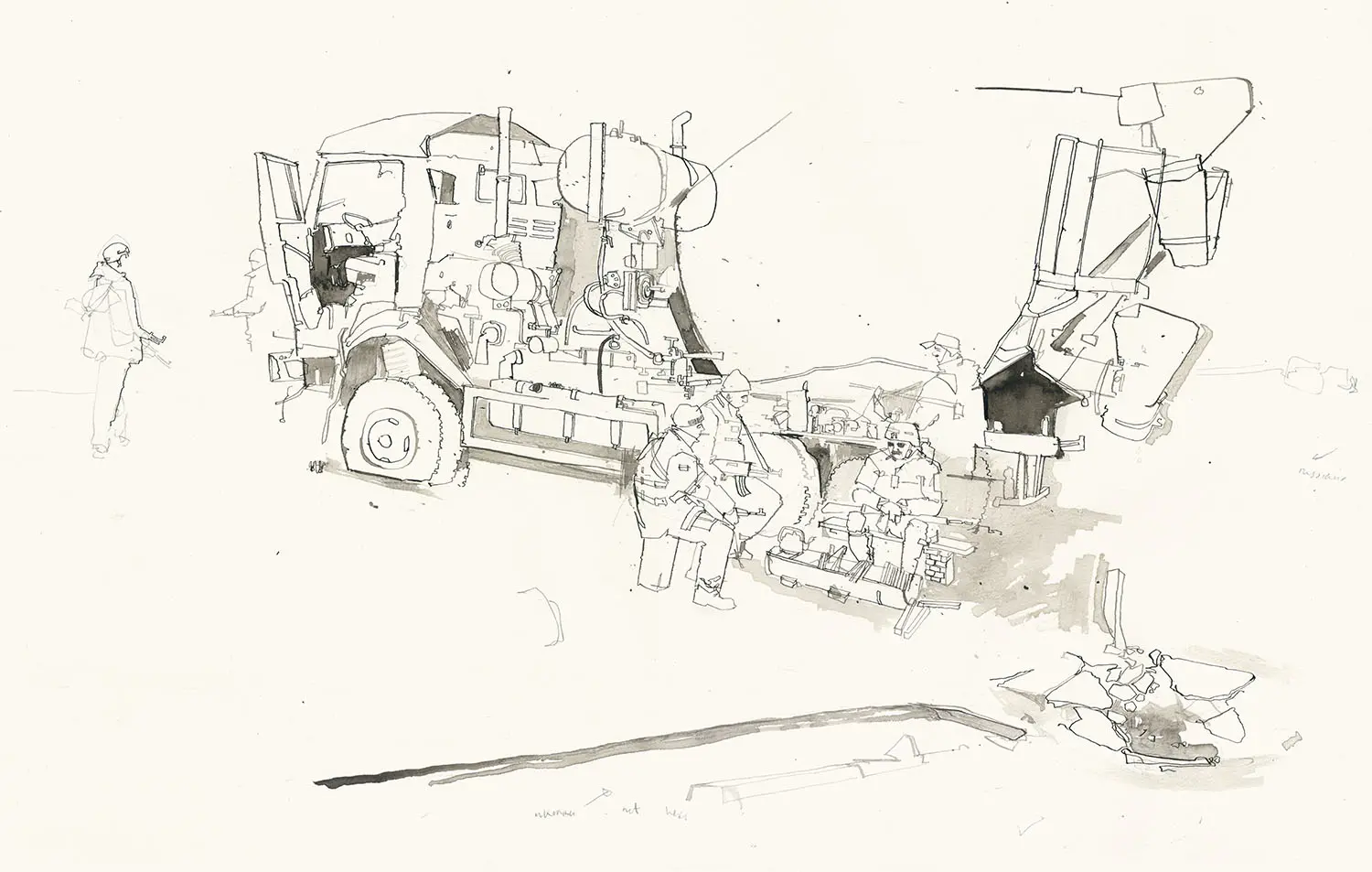
On the road south back to Kyiv, I stop to draw four soldiers sitting around a fire at the bottom of a blown-up cement truck. It is the last point the Russian army reached in its quest to take Kyiv. The soldiers are happy to let me to draw them, but when a photographer comes around they all find reasons to disappear. The road is covered in detritus, the odor of rotting flesh drifts past now and then. A body of a fairly large civilian lies face down outside the shattered shopping center. A pair of Russian soldiers lay naked and burnt on something melted and metal—left, presumably as a sign of ultimate disrespect. On the front of a nearby bulldozer used to block the Russian advance, Ukrainian forces have written, in Russian, 'Welcome to h---.'
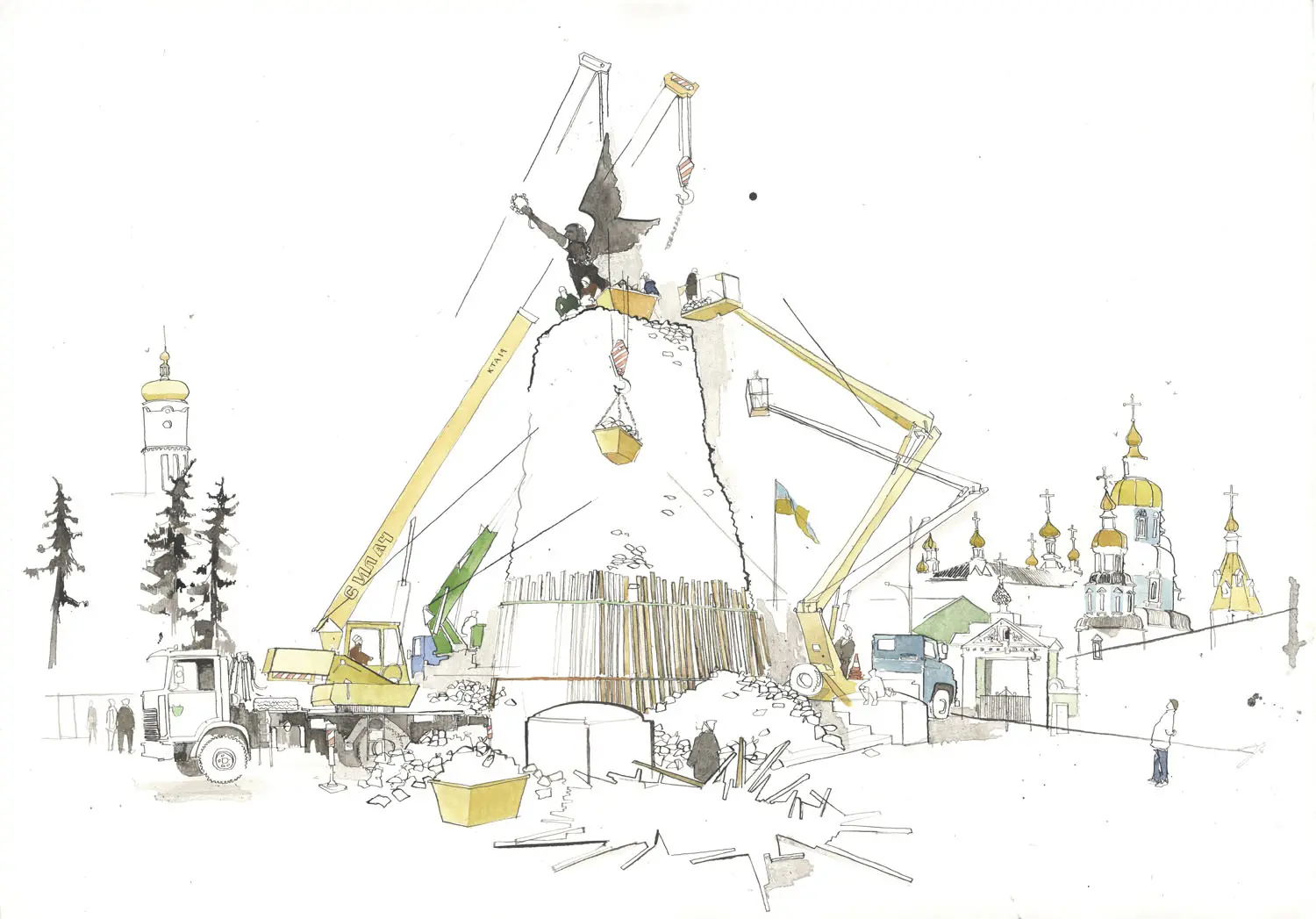
London
August 24
Those who left their homes, moved countries, gave up their jobs, signed on, buried loved ones, or paid the ultimate sacrifice—many of them hoped that this war, one way or another, would be over quickly. By summer we knew otherwise; perhaps some knew it all along.
Twenty-five thousand cases of alleged war crimes have, to date, been counted against Russia. By the end of July, there were more than 12,500 Ukrainian casualties, and, earlier this month, the Pentagon estimated Russia’s military casualties to be between seventy thousand and eighty thousand soldiers since the beginning of the war. It is thought that 6.3 million refugees have left Ukraine and more than 6.5 million are internally displaced. The growing figures are difficult to comprehend, nevermind giving each individual’s story its due.
The people I met, I only knew for several hours, significant for me because of their resolve and their humanity, though I suspect I was nothing more than just another reporter to them. That said, I can’t help but think of them.
Since April 8,more mass graves have been found in Borodyanka and Mariupol. One hundred and sixteen bodies were exhumed that week outside the Church of St. Andrew. Madame Olga died a few weeks after our interview, asleep in her bed on the fourth floor—peacefully, one would hope, though she never did get to see her great-granddaughter again.
Volodymyr still lives in the hospital in Kharkiv, but he’s learning to walk again. I lost touch with Lydia and her mother, Nina, in Hospital No. 1.
The Serpnia 23 metro station is no longer used as an air-raid shelter. As of this writing, the trains are running regularly, though the shelling hasn’t stopped. The dwellers have either returned home or fled west.
Sergey, the twenty-one-year-old medical student from the metro, has made it to Cambridge University in the UK, where he continues his studies in medicine.
The National Academic Opera and Ballet Theatre in Odesa reopened in June for the first time since the war began. They no longer play Russian music.
Reporting assistance for this story was provided by Yevheniia Shevchuk. Additional translation was provided by Andrea Odezynska and Megan Buskey.












